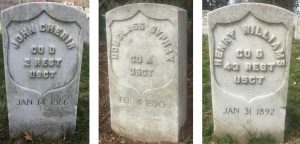Over the years, we have seen how the U.S segregates groups based on race, class, and religion. We can see remains (or lack of remains) of this privileged ideology in burial grounds.
We witness these episodes of mortuary discrimniation several times throughout history. One example we still can see today is right at the Arlington Cemetery in Virginia. This cemetery is quite famous for being the resting place of men and women of the armed forces. While visiting this grave site, you can come across multiple sections with the headstones marked “U.S.C.T.”. These initials stood for United States Colored Troops. The people buried in these sections were African-American soldiers who fought beside the American troops in the Civil War, but ultimately were not allowed to be buried next to them. This eventually expanded to include Black military veterans and civilians as well.
We can also see this in the individual case of Sgt. John R. Rice, a former member of the Winnebago tribe, who was killed in combat in Korea. 
The officials of the Sioux City Memorial Park Cemetery, Iowa, had stopped his burial. Right before the coffin could be lowered, his family was informed that the ceremony could not go on as “a clause in the sales contract for the cemetery lot reserved burial privileges for Caucasians only.” Only after lawsuits and intervention by President Truman was Sgt. Rice buried at Arlington National Cemetery with full military honors. This still left the family insulted and distraught as they battled the system that pushed for “racial whiteness beyond embodied, biological life”.
Cited Works:
Sherman, David. “Grave Matters: Segregation and Racism in U.S. Cemeteries.” The Order of the Good Death, 20 Apr. 2020, www.orderofthegooddeath.com/article/grave-matters-segregation-and-racism-in-u-s-cemeteries.
Joint Base Langley-Eustis. “Even in Death, Segregation Is Part of Our History.” Joint Base Langley-Eustis, 3 Apr. 2006, www.jble.af.mil/News/Commentaries/Display/Article/260425/even-in-death-segregation-is-part-of-our-history.
Further Readings:


How does the location of burial grounds further underscore the postmortem segregation? For example, who has access to aesthetically pleasing burial grounds, vs those that are located in a less accessible or ‘beautiful’ location?